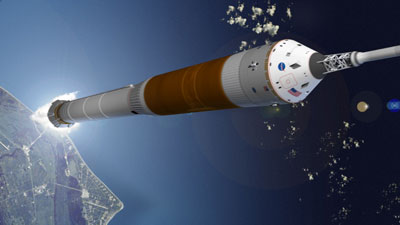So that’s what they mean by sustainable and affordableby Taylor Dinerman
|
| The important news is not that NASA has picked any particular date for resuming its manned space flights, but that it is planning to limit Orion to two missions a year. |
The lunar base plan that NASA set out late last year was also predicated on the idea that there will be no more than two Orion Moon missions a year after 2020. With these kinds of plans being made it is difficult to imagine that between 2016 and 2020 there will somehow be more than two flights a year. One concludes that the plan is to fly two Orion missions a year, whether to the ISS or the Moon, or elsewhere for the indefinite future.
Aside from not having to pay for the hardware for more than two Ares 1/Orion flights per budget cycle, the great advantage of this plan is that it provides realistic stability for both the space agency and for its contractors. The manufacturing rhythm and launch campaign will be able to proceed at a fairly leisurely pace without the schedule pressures that make life so difficult for Shuttle managers, operators, and astronauts. With only two flights a year NASA will be able to cut down on the huge “standing army” it needs for shuttle operations.
The implication of this two flight a year limit is that access for humans into low Earth orbit (LEO) will largely be the responsibility of the private sector. The COTS teams will fly people to and from the ISS as often as there are customers willing to pay. Passengers on these flights will include NASA astronauts who are part of the ISS crew, astronauts and mission specialists on temporary assignment to the station, astronauts and mission specialists from ISS partner nations, and “civilians”, who may be space tourists or corporate employees performing missions for their companies.
By 2015 human spaceflight may not be confined to just NASA, Russia, China, and the COTS teams. Virgin Galactic has plans to provide a commercial service and Lockheed Martin’s Atlas 5 with a capsule on top may be a contender. Indeed, if the Atlas 5 is successfully man-rated, a number of companies might use it to launch space vehicles. Lockheed could even find itself launching a commercial version of its own Orion spacecraft on trips to the ISS or to the Bigelow Aerospace space hotel.
The Orion missions to the ISS will not be the basic taxi type missions now performed by the reliable and well-understood Soyuz vehicle. They will probably be operational test and development flights that will allow NASA to shake out any bugs in the spacecraft in the relative safety of LEO. After that, the system will be ready for the lunar missions and later, perhaps, beyond.
It is worth noting that over the next few years the ISS will be visited by a whole new set of spacecraft, beginning with the European Automated Transfer Vehicle (ATV), followed by the Japanese H-2 Transfer Vehicle (HTV) and, later, by whatever US system emerges from the COTS program. All this creates a set of unusual challenges for the ISS management team. They will have to quickly learn how to cope with the unique docking and undocking procedures associated with each of these craft.
| COTS is without doubt the key to making the whole vision for space exploration “sustainable and affordable”. |
So far, only the Shuttle, Soyuz, and Progress vehicles have ever docked with the ISS. The approach and capture procedures are well understood and there is a solid body of experience to help the crews and mission controllers keep these movements safe and fairly smooth. There is none of that with these newer systems and the learning curve is inevitably going to be a steep one indeed. The ISS has two types of docking ports, one designed for Soyuz which, if ESA’s illustrations on their website are accurate, will be used by the ATV, and the US Pressurized Mating Adapter.
The HTV uses a capture and connect system. The vehicle will fly to with 10 meters or so of the ISS and is then grasped by the station’s robotic arm and is connected to one of the nodes. This is the same type of system that SpaceX is proposing to use on their Dragon capsule. Obviously, experience with the Japanese system will be extremely useful when the time comes to use SpaceX’s or similar COTS-derived systems.
COTS is without doubt the key to making the whole vision for space exploration “sustainable and affordable”. By limiting Orion flights to just two a year NASA opens up a whole new market for commercial space transportation suppliers. The demand for taxi service to and from the ISS will never be filled by just Orion and Soyuz together. There is plenty of room for the COTS suppliers, Virgin Galactic, and others to sell seats on their spacecraft, and to do so for much less than the current $20 million the Russians charge for a seat on a Soyuz.
In the longer term it may be possible for NASA to turn later versions of Orion into more of a pure deep space vehicle with its Earth return capability strictly reserved for emergencies. Commercial carriers could fly Moon- or Mars-bound astronauts into LEO where they could rendezvous with an “Orion Plus” vehicle.
This is all speculation, but if NASA does hold to the plan to launch no more than two Orions per year, the agency’s self-restraint will pay off in lower costs and in the development of a whole new space business. Over the years NASA has often squashed the hopes of commercial space service providers. Those whose fingers have been burned in the past will naturally need to be convinced, but COTS may be the catalyst that will change the way human spaceflight is bought and paid for.
